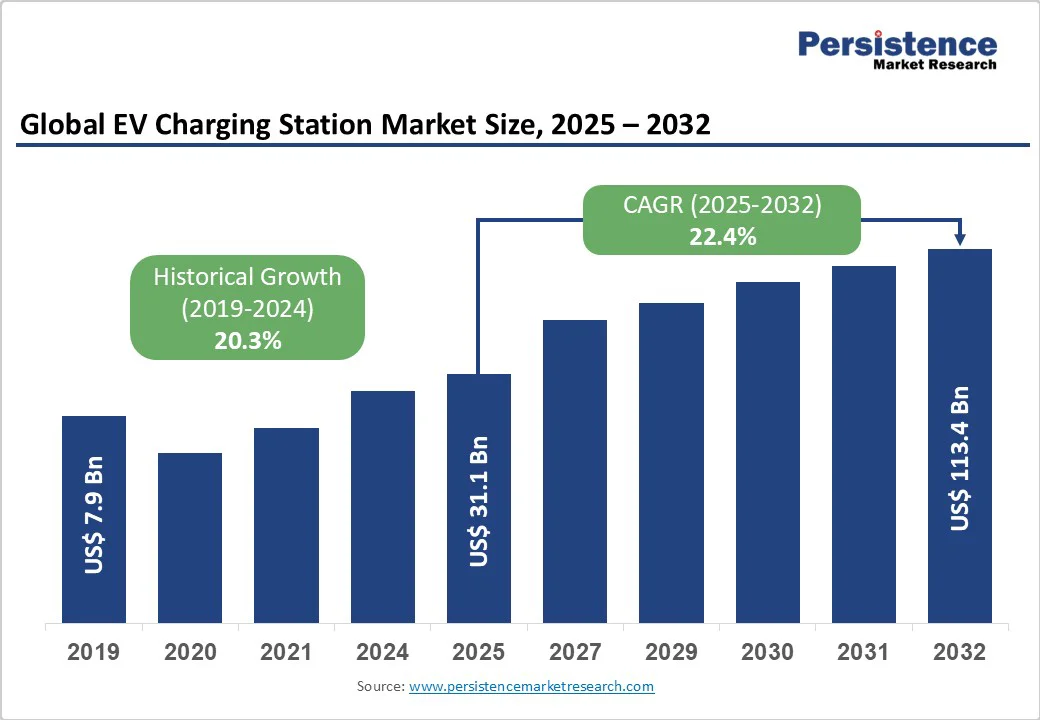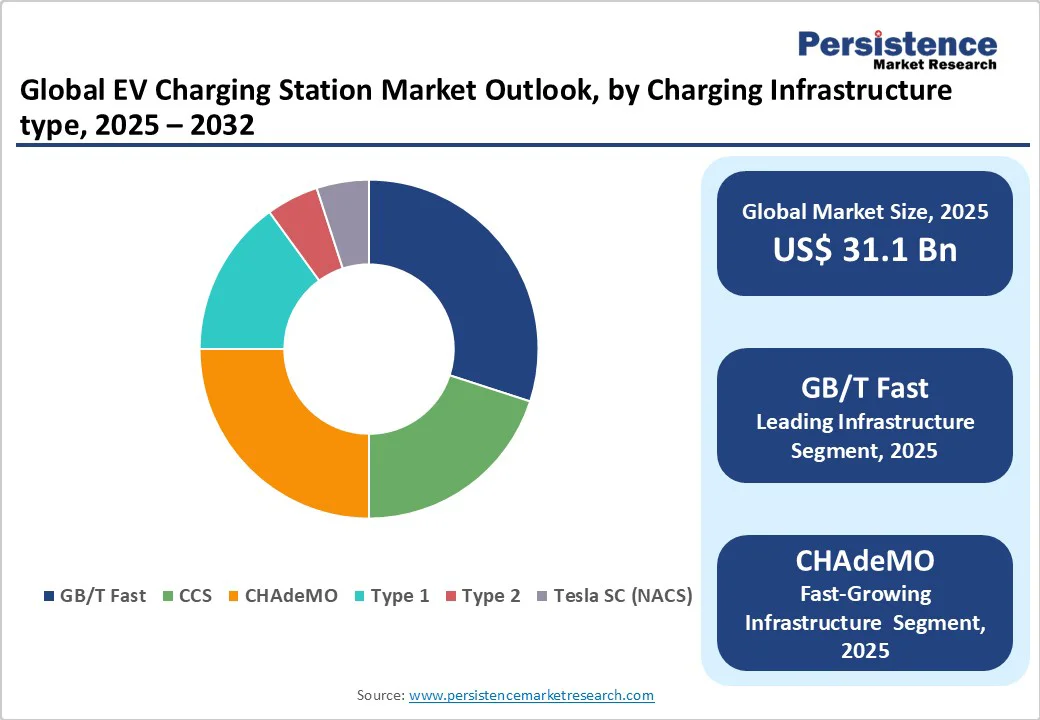ID: PMRREP13237| 196 Pages | 17 Oct 2025 | Format: PDF, Excel, PPT* | Automotive & Transportation

The Global EV Charging Station Market size is likely to be valued at US$ 31.1 Billion in 2025 and is projected to reach 113.4 Bn by 2032, growing at a CAGR of 20.3% till 2032. The rising adoption of electric vehicles (EVs) worldwide, government incentives, including tax exemptions and regulatory mandates supporting zero-emission vehicles, are accelerating EV adoption and subsequently boosting the demand for robust and accessible charging solutions.
| Key Insights | Details |
|---|---|
|
EV Charging Station Market Size (2025E) |
US$ 31.1 Bn |
|
Market Value Forecast (2032F) |
US$ 113.4Bn |
|
Projected Growth (CAGR 2025 to 2032) |
20.3% |
|
Historical Market Growth (CAGR 2019 to 2024) |
22.4% |

The growing global demand for electric vehicles (EVs) is significantly driving the expansion of EV Charging stations, with governments around the world actively funding its development and offering substantial subsidies. Favorable policy frameworks incentivize the installation of charging stations through reduced fees, tax benefits, and streamlined regulatory processes. Numerous countries have integrated large-scale charging infrastructure expansion into their broader EV adoption strategies, with both public and private investments playing a vital role.
In the United States, initiatives such as the deployment plan for 500,000 new charging outlets by 2030 exemplify this momentum. Private sector innovations including high-speed charging stations and emerging wireless charging systems, are also accelerating the infrastructure buildout. Addressing the growing infrastructure needs requires a coordinated approach involving supportive government policies, technological innovation, and public education campaigns.
The absence of standardized electric vehicle charging infrastructure remains a significant restraint to the growth of the global EV Charging Station market. As the market expands rapidly, inconsistencies in charging requirements and technologies across regions have become more pronounced. Different EV models and charging networks often require specific voltage levels and connector types, leading to interoperability challenges for consumers and service providers alike. For example, AC charging stations typically provide 120V AC (Level 1) or 208/240V AC (Level 2), while DC fast charging stations offer rapid charging at 480V. However, the fast-charging standards vary significantly across countries. Japan predominantly uses CHAdeMO, Europe and South Korea employ CCS2, the U.S. uses CCS1, and China relies on the GB/T standard.
This fragmentation complicates international travel for EV users and creates added costs for infrastructure developers who must install multi-standard chargers to accommodate diverse vehicle requirements.
The adoption of Vehicle-to-Grid (V2G) technology presents a significant opportunity in the EV Charging Station market. V2G-enabled charging stations allow bi-directional energy flow between electric vehicles and the power grid, supporting critical functions such as grid balancing during peak demand periods. This technology can reduce strain on the grid, minimize the need for costly infrastructure upgrades, and potentially lower energy costs for consumers through demand response incentives. Moreover, V2G enables electric vehicles to serve as mobile energy storage units, offering backup power during outages and emergencies enhancing energy security and resilience for residential and commercial users.
Several key manufacturers are already advancing V2G technology. Nuvve Corporation is a global pioneer in V2G services, offering platforms that aggregate EV batteries into virtual power plants. Similarly, Nissan has integrated V2G capabilities into its LEAF models, collaborating with energy providers across Europe and Japan. ABB and Siemens are also investing in V2G-compatible charging hardware, reinforcing the commercial viability of this emerging solution.
The commercial segment dominated the EV Charging Station market in 2025, driven by substantial government funding and private sector initiatives aimed at expanding public electric vehicle charging infrastructure (EVCI). This segment includes fleet charging stations, destination charging stations, bus charging stations, highway charging stations, and other publicly accessible charging points.
In support of this trend, public transport agencies are partnering with automakers and energy companies to install large-scale charging solutions. For example, in September 2022, bp pulse partnered with The Hertz Corporation to roll out a comprehensive EV charging network across North America. This initiative is aimed at supporting Hertz’s expanding electric vehicle rental fleet and providing charging access to its customers, reinforcing the commercial segment’s leading role in market growth.
The fast segment captured the largest share of 75% in 2025 and grow at the highest CAGR during the forecast period. The increasing requirements for AC fast chargers drives the segment growth, supported by the rising adoption of EVs in North America and government investments in electric vehicle charging stations. These developments and active investments in the sector are expected to further drive the segment.
The slow/moderate charger has also contributed to the rising adoption of standard chargers, particularly due to government efforts to expand efficient and sustainable EV charging infrastructure. For instance, with the help of Okaya, the Indian government announced plans to deploy 1,020 multi-standard chargers across India by 2025. Similar initiatives in other regions are also expected to drive segment growth.
GB/T connectors dominate the market with an expected 60% share in 2025, driven by their widespread use in China and compatibility with Guobiao National Standards. Supporting both AC and DC charging, the GB/T AC connector delivers up to 7.4 kW and resembles Europe’s Mennekes plug, though the two are not compatible due to differing cable configurations. The GB/T DC connector offers up to 237.5 kW of output, meeting the growing demand for fast charging in China’s expanding EV market.
The CHAdeMO segment is projected to grow at the fastest pace during the forecast period, propelled by the increasing adoption of DC fast-charging technology. Originally developed by Japanese automakers, CHAdeMO continues to gain traction across Asia and select global markets emphasizing high-speed EV charging.
Level 2 charging emerged as the dominant segment in the EV Charging Station market in 2025, owing to its optimal balance between charging speed, cost, and ease of installation. Operating between 208 to 240 volts, Level 2 chargers are ideal for residential settings, workplaces, and public charging stations. Capable of adding 12 to 80 miles of range per hour depending on the EV model and the charger's power output, Level 2 charging is significantly faster up to 10 times than Level 1 charging.
Its widespread adoption is attributed to the convenience it offers urban EV users, where demand is highest. The relatively simple installation process, coupled with high compatibility across vehicle types, has made Level 2 chargers the most commonly deployed solution globally. As of 2022, this infrastructure has become a cornerstone of city-based EV adoption strategies.

Asia Pacific dominates and accounted for a 60.4% revenue share in 2025. Countries such as China, Japan, and South Korea, known as hubs of electric vehicles, are heavily investing in the development of charging infrastructure. Currently, China has one of the highest shares of fast chargers out of total public charging stock, at around 45%. In both the STEPS and APS, the stock of public fast chargers reaches around 7.5 million in 2035, almost six times 2023 levels. The number of slow chargers reaches 8.2 million in 2035 in the APS.
Japan's Green Growth Strategy aims to deploy 150,000 charging points by 2030, including 30 000 fast chargers, with the objective of reaching a comparable level of comfort as for refuelling conventional vehicles. In the APS, the number of LDV charging points reaches 160 000 by 2030, of which approximately 55 000 are fast chargers. By 2035, the number of public charging points will reach 190 000 in the APS. The number of electric LDVs per public charging point increases from around 18 in 2023 to over 80 in 2035 in the APS.
North America’s electric vehicle (EV) charging infrastructure market is rapidly expanding, valued at approximately USD 4.17 billion in 2025 and projected to reach over USD 43 billion by 2032, driven by surging EV adoption and supportive government initiatives. The U.S. leads with significant investments, including a $1.5 billion allocation under the National Electric Vehicle Infrastructure (NEVI) Formula Program to develop charging stations along 75,000 miles of highways.
In the U.S, the government has announced nearly USD 50 million to subsidize projects that aim to expand access to convenient charging, in line with its objective of building a national network of 500 000 public EV charging ports by 2030. In the APS, the number of public chargers reaches 900 000 in 2030 and 1.7 million in 2035, many of which will likely be funded by private investment and go beyond highway corridors. This translates to about 55 electric LDVs per charging point in 2035.
Europe is planning to achieve net zero emissions by 2050. Moreover, most companies are entering the market in the region. For instance, in March 2023, BP Pulse opened its most significant, most potent EV charging hub in the U.K., at Kettering, North Northamptonshire, built by The EV Network and operated by BP Pulse. Such investments are leading to regional growth.
The United Kingdom expects to install at least 300 000 public chargers by 2030. In the APS, the roll-out of public chargers is slightly slower but maintains adequate coverage in terms of charging capacity available, with the stock reaching only 220 000 in 2030, with 1.2 kW of charging capacity per electric LDV available, and reaching 300 000 5 years later in 2035. Considering the stock of electric LDVs approaches 20 million in 2035 in the APS, this corresponds to over 60 electric LDVs per public charging point, up from around 30 in 2023.
The global EV charging station market is highly competitive, with established industry leaders and emerging startups competing to capture market share through innovation, technological advancements, and strategic integration with AI, IoT, and smart grid solutions. Major players are heavily investing in research and development, focusing on improving charging speed, network reliability, energy management, and seamless user experiences to offer greater value to both individual consumers and fleet operators.
Leading companies are forming strategic partnerships with automakers, energy providers, and technology firms to accelerate deployment, expand geographic reach, and deliver end-to-end charging solutions. Integration with renewable energy sources and the development of smart, cloud-connected charging platforms are key trends shaping competitive strategies.
The EV Charging Station market is estimated to be valued at US$ 31.1 Bn in 2025.
Rapid Growth in Electric Vehicle (EV) Adoption, and Corporate and Public-Private Partnerships are the major growth drivers.
In 2025, the Asia Pacific region will dominate the market with an exceeding 35% revenue share in the global EV Charging Station Industry.
Among the Charging Infrastructure Type, Passenger Service Equipment holds the highest preference, capturing beyond 32.7% of the market revenue share in 2025, surpassing other parts.
The global EV Charging Station market is dominated by major players such as ABB Ltd., ChargePoint, Inc., Leviton Manufacturing Co., Inc., Blink Charging Co., and Tesla Inc.
| Report Attribute | Details |
|---|---|
|
Historical Data/Actuals |
2019 - 2024 |
|
Forecast Period |
2025 - 2032 |
|
Market Analysis |
Value: US$ Bn, Volume: Units |
|
Geographical Coverage |
|
|
Segmental Coverage |
|
|
Competitive Analysis |
|
|
Report Highlights |
|
By Charger Type
By Charging Infrastructure Type
By Installation Type
By Level of Charging
By Application
By Region
Delivery Timelines
For more information on this report and its delivery timelines please get in touch with our sales team.
About Author